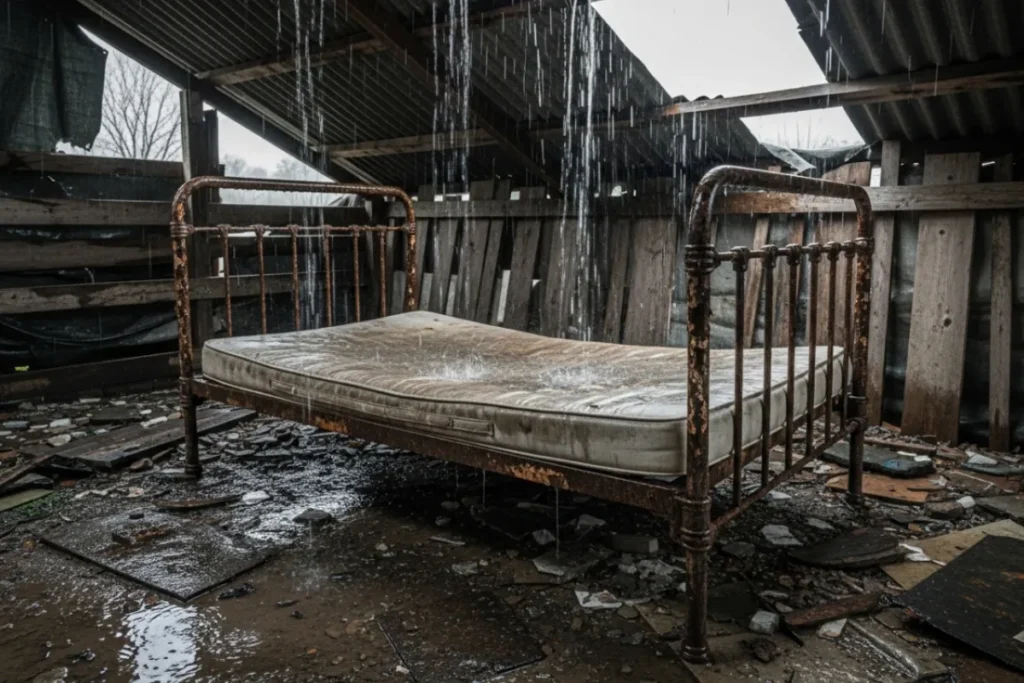Examine the complex connection between comfort, the Bed, and social inequality. This comprehensive article examines historical perspectives, cultural differences, and the psychological impact of sleep conditions on overall well-being. Explore how access to adequate sleeping arrangements is influenced by socioeconomic status and discover initiatives aimed at bridging the comfort gap. By recognizing the multifaceted nature of comfort, we can work towards a more equitable society in which restful sleep is a right for all, rather than a privilege for just a few.
Table of Contents
Introduction to the Concept of the Bed
Comfort is a multifaceted concept that transcends mere physical relaxation; it encompasses emotional well-being, mental peace, and social standing. The experience of comfort is subjective, varying significantly from one individual to another based on diverse factors such as culture, personal preferences, and socioeconomic conditions. For many, comfort may be found in luxuriously furnished rooms, complete with plush beds and high-quality bedding. In stark contrast, others may experience discomfort due to inadequate sleeping conditions defined by limited resources and precarious living situations, highlighting the intersection of the bed and social inequality.
In various cultures, the definition of comfort has evolved alongside historical context and social structures. For example, in societies that prioritize communal living, the concept of comfort may not include the individualistic notion of a personal bed but rather collective spaces for rest. This reflects a broader understanding of sleeping rights and dignity, pushing against the traditional narrative that associates comfort with material wealth and privilege. Such views prompt a crucial conversation around how access to restful sleep can mirror systemic inequities present in society.
The connection between furniture and privilege, particularly in the context of the bed, reveals the stark disparities surrounding comfort. In affluent households, beds are often symbols of luxury, whereas many people experience a harsh reality where the lack of a proper bed serves as a reminder of rest and poverty. As we explore the evolving perceptions of comfort throughout history, we notice how it is influenced by economic conditions and societal norms, serving not merely as a personal luxury but as a poignant reflection of a society’s values.
Historical Perspective on Sleep and Comfort
The evolution of sleeping arrangements and the concept of comfort have been intricately linked to societal hierarchies throughout history. From ancient civilizations to the present day, the evolution of the bed has mirrored social structures, emphasizing both privilege and disparity. In many early societies, sleeping arrangements varied widely based on class. For instance, in ancient Egypt, royalty enjoyed opulent sleeping spaces adorned with fine linens and luxurious materials, while the lower classes often rested on simple mats or even the ground. This stark contrast highlights how social inequality was pervasive, influencing not only daily living but also the fundamental aspect of rest and dignity.
As civilizations progressed, so did the construction and significance of beds. In medieval Europe, elaborate four-poster beds became symbols of status. The wealthy adorned their bed with sumptuous textiles and engaged in specific rituals surrounding sleep, which were not available to the impoverished. Such arrangements not only offered comfort but also reinforced the idea of sleeping rights as privileges. The bed transitioned from a mere utilitarian object to a statement of wealth, accentuating the division between classes. Within the context of furniture and privilege, the material conditions of sleep could either enhance or diminish a person’s dignity.

The Role of Class in Defining Comfort
In contemporary society, the concept of comfort, particularly about sleeping arrangements, is heavily influenced by socioeconomic status. Access to high-quality mattresses, beds, and well-maintained bedroom environments often hinges on financial capability, highlighting stark disparities in sleeping rights and dignity across different income brackets. Studies have shown that individuals from lower socioeconomic backgrounds frequently encounter challenges in obtaining comfortable sleep, which can affect their overall health and well-being.
A 2021 survey conducted by the Sleep Foundation revealed that over 50% of low-income households reported their sleep quality as “poor” compared to just 22% of those in higher income brackets. This disparity is indicative of the broader contrast between rest and poverty, where financial constraints limit access to essential furniture, such as the bed that promotes adequate sleep. Furthermore, this lack of comfort can perpetuate cycles of health issues, illustrating how furniture can represent privilege in modern life. The quality of one’s bed and sleeping conditions becomes more than a matter of preference; it becomes a determinant of physical and mental health.
Historically, beds have symbolized status and wealth, evolving from rudimentary sleeping arrangements to luxurious sanctuaries. In medieval times, for instance, the size and quality of the bed often reflected one’s social standing. Similarly, the current market for bedding showcases an array of options from basic to high-end, emphasizing how furniture choices are intertwined with class status. In a world where many individuals struggle to secure fundamental comforts, the connection between bed and social inequality becomes alarmingly apparent. Recognizing these dynamics is vital for fostering a more equitable society, where access to comfort should not be viewed as a luxury exclusively afforded to the privileged.
Psychological Implications of Sleeping Comfort
Sleep plays a critical role in maintaining mental health and well-being, with the quality of one’s sleeping environment significantly impacting overall psychological health. The relationship between bed comfort and mental wellness cannot be understated, as inadequate sleeping conditions can lead to a multitude of psychological issues. For individuals experiencing social inequality, a lack of access to comfortable beds symbolizes not just a physical deficiency but also a deprivation of basic dignity and sleeping rights. The resulting discomfort can hinder the ability to achieve restful sleep, which is paramount for cognitive function, emotional regulation, and resilience against stress.
The stark contrast between rest and poverty is particularly striking in socioeconomically disadvantaged communities. Many individuals in these groups routinely endure poor sleep quality due to inadequate furniture and privilege disparities. The mental fatigue stemming from insufficient rest has far-reaching consequences, potentially exacerbating anxiety, depression, and other mental health disorders. Moreover, when one consistently faces subpar sleeping conditions, it can create a pervasive sense of hopelessness, undermining aspirations and achievements. This cycle reinforces existing social inequalities, as those without access to basic comforts like beds struggle to break free from their circumstances.
Historically, the evolution of beds serves as a lens through which we can examine societal values surrounding comfort and privilege. From rudimentary sleeping arrangements to luxurious beds, the progression reflects broader societal attitudes concerning worth and humanity. However, the gap in sleeping conditions today perpetuates the historical injustices faced by marginalized groups. With every missed opportunity for restorative sleep, the divide deepens, illustrating how essential it is to recognize the psychological ramifications of sleeping comfort in the context of social inequality. Emphasizing the need for equitable access to proper sleeping arrangements transcends simple human necessity; it is a matter of dignity and respect for all individuals in society.

Cultural Approaches to Sleep and Comfort
Across various cultures, the concepts of sleep and comfort manifest in distinct ways that are deeply intertwined with societal values, economic conditions, and historical contexts. In many societies, the bed serves as more than just a piece of furniture; it embodies the ideals of rest, dignity, and the comfort that individuals strive for within their unique social frameworks. The examination of beds across history reveals significant disparities that reflect broader themes of privilege and social inequality.
In Japan, the traditional futon provides an interesting case study. Futons are placed directly on the tatami floor, embodying a minimalist style that emphasizes simplicity and functionality. This practice aligns with cultural values that prioritize a fluid use of space and the idea of impermanence. As Japan’s economic landscape evolved, so did sleeping arrangements; luxury hotel chains now cater to those able to afford a lavish bed with specialized bedding, illustrating a contrast between the economic classes and their respective sleeping rights and dignity.
Conversely, in Scandinavian regions, the concept of “hygge” emphasizes coziness and comfort, often associated with well-designed furniture and sleeping environments. Here, the bed is adorned with high-quality linens, luxurious comforters, and ample pillows to create an inviting atmosphere for rest. This culturally ingrained appreciation for comfort reflects a society that champions equality and welfare provisions, thereby granting access to dignified sleeping arrangements for a larger segment of the population.
Moreover, in many indigenous cultures, sleep spaces are communal and adaptable, highlighting a connection to community ties rather than individual privilege. As societies grapple with varying economic realities, it becomes evident that the contrast between rest and poverty shapes the availability and accessibility of comfort in sleeping arrangements. This cultural landscape underscores how attitudes toward beds and comfort mirror the underlying social structures and inequalities prevalent in different regions worldwide.
Solutions for Bridging the Comfort Gap
The disparity in bed comfort directly relates to broader issues of social inequality. To effectively address this gap, a multi-faceted approach is required that prioritizes equitable access to sleeping rights and dignity. Community initiatives can play a significant role in providing both awareness and resources aimed at enhancing the comfort of those who struggle with poverty. Initiatives such as community bed drives can ensure that individuals lacking adequate bedding have access to quality furniture that supports restful sleep, thereby improving their overall well-being.
Collaboration with non-profit organizations is another vital avenue for bridging this comfort gap. Organizations focused on addressing homelessness and poverty can spearhead projects that distribute comfortable beds and bedding. Such initiatives may also include educational programs targeting the importance of sleep for mental and physical health. Moreover, engaging with local businesses to sponsor these programs can amplify their reach and impact.
In addition to grassroots movements, the market for innovative products can also offer meaningful solutions. Companies that design multifunctional furniture specifically intended for low-income households can dramatically alter the landscape of sleep comfort. For example, compact beds that can serve multiple purposes without sacrificing quality can help alleviate the financial burden while providing essential comfort. Moreover, the introduction of budget-friendly brands promoting affordable bedding solutions can democratize access to quality sleep, challenging the traditional notion of beds as a class privilege.
Policymakers must recognize the link between rest and poverty contrast, fostering an environment where sleeping rights are considered a fundamental need rather than a luxury. By addressing these gaps collectively, society can move towards ensuring that everyone, regardless of socioeconomic status, has access to the comfort and dignity that a good bed provides.

Interviews with Experts and Affected Individuals
To explore the intricate relationships between bed comfort, social inequality, and overall well-being, we conducted interviews with both experts in various fields and individuals who have faced challenges regarding their sleeping conditions. These conversations revealed the significant impact that access to quality beds has on physical health, mental stability, and societal participation.
Psychologists emphasized that sleep quality is essential not only for cognitive function but also for emotional regulation. Dr. Emily Carter, a clinical psychologist, noted that inadequate sleeping conditions can exacerbate feelings of anxiety and frustration, particularly in marginalized populations. “When individuals lack basic comforts, such as a good bed, it fuels a sense of deprivation,” she said. This deprivation can lead to a cycle of poor sleep, which affects daily life and social engagement, thus perpetuating social inequality.
Sociologists provided a broader framework, highlighting how the disparities in sleeping conditions often reflect wider societal issues. Professor James Thompson discussed the correlation between sleeping rights and societal privilege. “Access to quality furniture like beds often correlates with economic status,” he observed. Individuals from lower-income backgrounds may struggle to find adequate bedding, further trapping them in cycles of poverty.
Additionally, we spoke with individuals who have experienced these disparities firsthand. Maria, a single mother of three, shared her struggle to provide comfortable sleeping arrangements for her children. “We make do with what we have, but I often worry about how this affects their health and education,” she remarked. Her story illustrates the real-life challenges many face, highlighting the stark contrast between rest and poverty.
These insights collectively underscore how beds are not merely items of furniture but are deeply intertwined with issues of privilege and social inequality. Access to comfortable sleeping arrangements should be viewed as a fundamental right, critical for the dignity and well-being of every individual, irrespective of their socio-economic status.
Case Studies: Comfortable Living in Different Classes
The disparities in sleeping arrangements often reflect broader social inequalities, highlighting how furniture, such as beds, can symbolize privilege and class stratification. In affluent neighborhoods, individuals typically enjoy exceptionally comfortable sleeping arrangements. For instance, a family living in a high-income area may have memory foam mattresses, luxurious bedding, and even adjustable bases that cater to their specific sleep needs. This level of comfort ultimately contributes to improved overall health and well-being, underscoring the profound impact that access to quality furniture can have on the quality of life.
In contrast, in lower-income communities, the scenario is starkly different. Families may be forced to share a bed, often utilizing makeshift sleeping arrangements that compromise both comfort and dignity. For example, a single mother and her two children might sleep on a worn-out mattress with inadequate support. This lack of proper sleeping rights not only affects the health of family members but also their emotional and psychological well-being. The stress associated with insufficient rest can have far-reaching consequences, including impaired cognitive function and heightened anxiety levels.
Additionally, historical perspectives shed light on how the bed has played a pivotal role in shaping social classes. Throughout history, sleeping arrangements have been a stark divide among social strata. The medieval era showcased how the peasantry was often relegated to straw-filled pallets on the ground, while nobles rested on elaborate featherbeds. Today, while our society has evolved, the contrast remains evident, illustrating how rest and poverty continue to intersect in modern contexts. Analyzing these case studies illuminates not only individual hardship but also the systemic issues underlying social inequality.
| Category | Sleeping Arrangement | Example | Impact on Health & Well‑Being | Social Symbolism |
|---|---|---|---|---|
| Affluent Neighborhoods | High‑quality beds with luxury features | Memory‑foam mattresses, plush bedding, adjustable bases | Poor sleep, impaired cognition, increased stress, and anxiety | Privilege; class status; comfort |
| Lower‑Income Communities | Shared or makeshift sleeping setups | Single mother and two children on a worn‑out, unsupported mattress | Feudal hierarchy, power divide | Lack of resources; dignity compromised |
| Historical Perspectives (Past) | Stratified by social class | Peasants on straw pallets vs. nobles on elaborate featherbeds | Peasants: discomfort and health risks; nobles: restful luxury | Poor sleep, impaired cognition, increased stress and anxiety |
Conclusion: Redefining Comfort for All
In examining the multifaceted relationship between the bed and social inequality, it becomes evident that access to adequate sleeping accommodations reflects broader systemic issues related to privilege and socioeconomic status. Throughout history, the quality and availability of furniture—including beds—have often delineated social strata, impacting the dignity associated with sleeping rights. This contrast between rest and poverty illustrates a dire need for societal change; comfort should not remain a mere luxury afforded to a select few, but rather a fundamental right accessible to all individuals.
To address the disparities in sleeping arrangements, society must adopt a holistic approach. This entails prioritizing initiatives that promote affordable housing, ensuring that every individual has access to proper sleeping facilities that contribute to their health and well-being. Non-profit organizations and community programs can play a pivotal role in facilitating access to beds and improving living conditions for those in need. Furthermore, fostering partnerships with manufacturers of furniture can aid in distributing the bed to disadvantaged communities, thereby reducing inequality in sleeping accommodations.
Additionally, public awareness campaigns that highlight the importance of sleep and its direct correlation with mental and physical health can cultivate a more empathetic society. Such efforts are crucial in shifting public perception, emphasizing that restful sleep should be viewed as a collective necessity rather than a privilege based on wealth. By advocating for sleeping rights as a fundamental aspect of dignity, society can work towards redefining comfort for all, establishing a future where equitable access to quality rest is no longer an aspiration but a reality.







